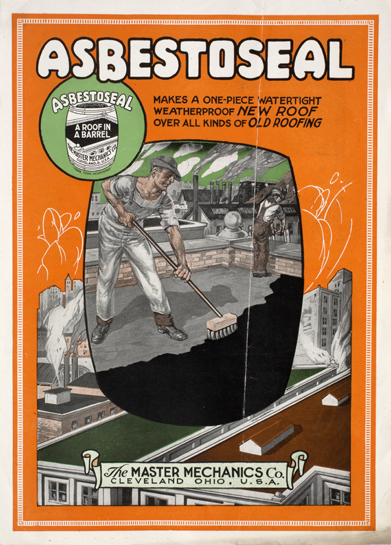01. "Asbestoseal." The Master Mechanics Company; Cleveland, OH; c.1920-1922.
Asbestos—a word now synonymous with “carcinogen”—has been used for a variety of purposes for thousands of years. Ancient Greeks and Romans referred to the material as “the magic mineral” due to its fire- and acid-resistant properties, and its high strength to weight ratio. During the industrial revolution it was resurrected as insulation for boilers, steam pipes, turbines, ovens and kilns, and later as cloth for theater curtains, a base for filter material, in brake linings, and as fireproof cement and putty. Virtually inert, asbestos was also relatively inexpensive, and easily manipulated or even decorated.
As the use of asbestos spread rapidly in the 20th century, so did warnings of its ill effects. Asbestosis, a chronic lung disease, was first identified in 1927 by W.E Cooke, who noted the “curious bodies” (i.e., asbestos fibers) associated with it. The first comprehensive study of the health effects was conducted between 1928 and 1930, followed by the first asbestos regulations, which came into force in the UK in 1933. However, it was not until a 1960 paper on mesothelioma was published that the hazards behind asbestos exposure became broadly accepted by the medical community. In May of 1972 an American asbestos worker named Claude J. Tomplait won the first lawsuit in the U.S. against an asbestos manufacturer, which soon brought tens of thousands of similar claims. Its use in an “unprotected or unconfined state” was banned in the U.S. in 1973, though it remained in use in other countries for many years afterward.
"Tools of the Trade: 19th- and 20th-Century Architectural Trade Catalogs," Case 3, Ryerson & Burnham Libraries, August 4, 2015-October 12, 2015.
Link to R&B Archives Digital Collections record

